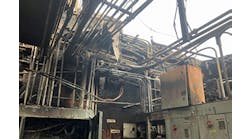"Cross-functional teams with process engineers, IT, reliability staff and others can be a big help with digital transformation.” ADM’s Gopal Elumalai discussed how individuals from different functional organizations can help advance each other’s digital competencies.
Having too much choice is no blessing because it can freeze decision-making and paralyze much-needed action. So, while all of today's emerging Industrial Internet of Things (IIoT) devices and software are exciting, they can't do any good if users don't know which ones will be the most useful and successful in their individual applications.
These were the issues debated by experts from ADM, Amway and Grupo Bimbo, who joined the "Set the course for digital manufacturing in food and beverage" panel during the Food & Beverage Industry Forum at this week’s Rockwell Automation Fair at Home.
"When we're talking digital transformation, it depends on which plant you’re talking about,” said Rob Dargie, senior electrical engineer at Amway. “Older plants are usually just at the beginning, while newer plants may already have digitalized tools deployed. We ask users what they need, and they usually say 'everything.' So, we first have to define what data they actually need because they don't need it all, even though it might seem nice to have it.
"Of course, the most desirable outcome is live data that lets users see their processes,” Dargie said. “We're getting up to speed on this at one of our newest plants, which is delivering live data to servers that used to be recorded on paper."
Gerald Holt, senior director of global power and control, Grupo Bimbo, added that his company is also getting aggressive about digitalization at its plants, and that the pressure to adopt is streaming down through management. "As always, we're seeking greater efficiency and quality in our plants, so that's going to drive our definition of digitalization," said Holt. "One thing we know for sure is it's going to be an everlasting journey."
Down to devices, up to the cloud
Because changes and adjustments due to digitalization will be ongoing, Gopal Elumalai, manager of solutions architectures and IIoT technologies at ADM, explained that ADM is moving from a traditional, siloed organizational to being more dynamic, demand-driven and collaborative. "Digital transformation isn't going to stop with industry 4.0. It will be part of industry 5.0 and whatever comes after," explained Elumalai. "We need to go through our manufacturing facilities, find pain points, and make them the focus of our digital transformation efforts. We know we can start small, but we also know that we need to connect lower-level devices."
At its most basic, digital transformation is about adding microprocessors and Ethernet ports to industrial equipment and related devices, connecting them to the Industrial Internet of Things (IIoT), and trying to make them cybersecure, said Holt. And, once many components have been Internet-enabled, the next major step is usually signing up for a cloud services subscription.
"We're all beginning to realize the power that cloud computing can spin up rapidly, especially in enabling causal analytics," said Holt. "We still need edge devices to collect data, but they and mobile devices can quickly connect to the cloud for deep analyses, and do it without requiring lots of computing equipment onsite."
First step? Assess and secure
To kick off a digital transformation program, Dargie recommended a thorough inventory and assessment of what hardware and software is already in each plant. "We used to know more about the technologies we had on hand, but much of it's old and has connectivity issues," he said. "We also need to assess our devices to learn how they communicate and how we can protect their deterministic pathways because security is essential, too."
Holt reported that Grupo Bimbo has 180-200 plants with varying automation levels and plenty of legacy devices such as PLC-5 controllers, but more plants will begin to modernize as Wi-Fi matures and as emerging 5G allows more deterministic communications, which will let users configure in the connectivity they need and the security that goes with it. "Cybersecurity is a big concern with all of this because of the potential for damage, so we're seeking multi-tiered security that goes all the way down to the device level," said Holt. "A couple of the resources we're using for cybersecurity are the ISA 99 standard and the Converged, Plantwide Ethernet (CPwE) guidelines from Cisco and Rockwell Automation about how to deploy firewalls and other devices."
Dargie added that information technology (IT) and operations technology (OT) staffs used to handle cybersecurity by staying in their own silos, but this meant they couldn't learn much from each other. "We have many IT departments, infrastructures and end users at different facilities, so we needed a collaborative team to come together," he explained. "In general, IT has been dealing with cybersecurity issues for 25 years, so they have a lot of experience that can help users at the OT level, who have just been dealing with cybersecurity for 5-10 years."
Working the workforce
Beyond addressing its technical and security aspects, the panelists reported that digital transformation can be greatly enabled or held back by the very same people trying to get it off the ground in their organizations.
"Workforces are a lot different than they were 25 years ago," said Holt. "Tablet PCs and smart phones are making many people more computer literate as they download apps and make bank payments, even though these tasks can be more of a challenge for more senior personnel, who are often set in their ways. Digital transformation can help more of them adapt. Plus, new blood and younger staffers are good, too, because they're often more open to new ideas and changes, and blending them into their work as appropriate. That's why we're bringing in more recent graduates, but doing it gradually for the best results."
Because workforce habits and strategies often grow up organically and vary between facilities, Elumalai added that managers and leaders need to develop and communicate a common vision—and do it early—so everyone knows what kind of digital transformation the organization is trying to achieve.
"Cross-functional teams with process engineers, IT, reliability staff and others can be a big help with digital transformation," said Elumalai. "Some parts of a team may be in exploration mode, while others already know what they want to accomplish, but including both will help them align their digital transformation goals."
Elumalai acknowledged that digital transformation comes with some costs, and that its advocates will have to show how a return-on-investment will be achieved, but this will almost certainly be more cost-effective than trying to keep using their legacy technologies. "We can't keep using legacy equipment forever," added Elumalai. "Digitalized solutions like cloud computing just have to show in real terms how they can boost returns and scale up. This is all driven by determining what I'm going to do with a digitalized solution, whether it's letting stakeholders collaborate, enhancing automation and controls, or improving quality. We all want a holistic roadmap for our plants. We just have to determine what digital transformation can do for us, and use that knowledge to decide on a common goal."
The editors of Control, Control Design and Smart Industry are providing coverage of Automation Fair At Home, bringing you breaking news, innovations and insights from the virtual event. Once Automation Fair At Home is over, the editors will put together an event report featuring the top news. Pre-order your copy today.







